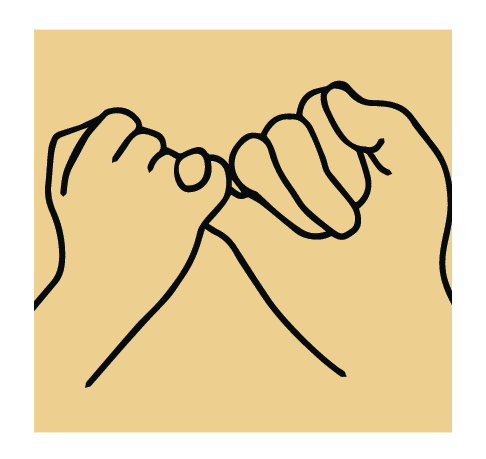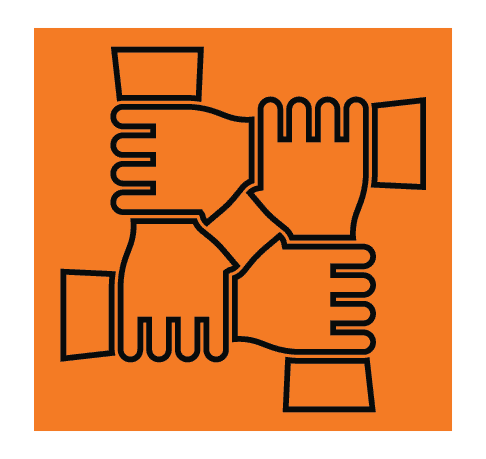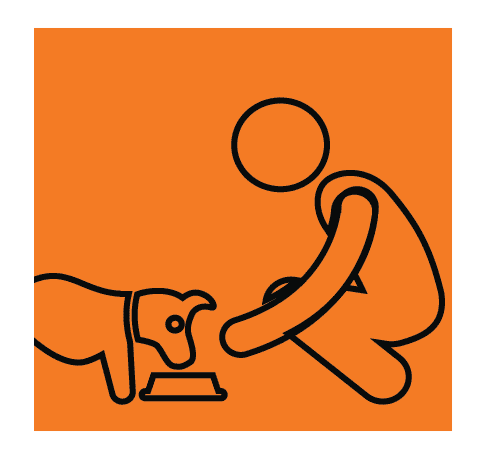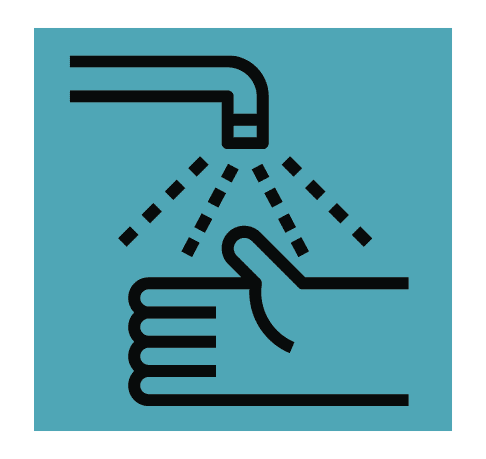
Trustworthy
Wind in the Willows
Source: https://masnational.org/p7d
Game Description
Use this group building game to build community, teamwork, and trust within the group as members rely on the support of the group to prevent themselves from falling.
Game Materials
Blindfold (optional)
Game Preparation
This game requires a minimum of 8-10 persons to have an appropriate sized circle. Impress upon participants that this is not a time for joking around, but a time to be serious and inspire trust in each other. They need to be encouraging and affirming, helping to alleviate the fear associated with trusting someone else.
Game Play
- Blindfold one volunteer or have them tightly shut their eyes.
- The group of 8-12 people form a circle shoulder-to-shoulder around the blindfolded volunteer. Spacing is determined by crossing their arms across the chest, palms gripping opposite shoulders and facing toward the inside of the circle.
- The blindfolded volunteer is to then to keep a stiff back and fall backward pivoting only on the heels of the feet to allow freedom of movement. The rest of the body should be kept straight.
- Those in the circle carefully pass the volunteer around the circle using their hands as a willow gently flexing in the wind.
- On occasion gently change the direction of the volunteer being passed around the circle. The volunteer is totally under the control of those in the circle.
- Allow each member of the group to try being the volunteer.
Discussion Ideas
- Trust: How did it feel be forced to rely on someone else? What fears did you have? Did you trust they would prevent you from harm? How does this relate to trusting God with our lives?
- Support: In this game we have to support someone in the group. Do we as a group have an obligation to look out for each other? What are some of the ways we can support each other in our lives?
- Reliance: In this group, the person in the center had to rely on the group. What are some of the ways we have to rely on each other in the Christian life? Do we need each other?
Snakes
Source: https://masnational.org/snakes
Content
Number of Participants: 2-30
Time: 10-15 minutes
Activity Level: Low – Moderate
Props: Blindfolds, Throwables, Buckets, Rope/Tape for barrier
Objective: For every member of the team to place a throwable into the bucket.
Set Up: Create a large circle barrier with the tape or a rope. Place a bucket in the middle of the circle. Toss the throwables randomly inside the barrier.
Description:
It is very important to ensure and instill a sense of trust within the group before attempting this activity. Please do not try Snakes before building trust on a smaller/safer level. Sequence several build-up trust activities prior to Snakes.
Depending on the amount of people in the group, ask the participants to get into teams of 5-7 people. Ask the participants to standing in the very back of the line. This is a no-talking activity, but allow the group to take 1-2 minutes to pre-plan. The person in the back of the line will guide the participants around the circle barrier by simply tapping the shoulders of the person in front of them, who will tap the shoulders of the person in front of them, and then be guided to the bucket where they will drop the throwable.
When a participant drops the throwable into the bucket, they will then remove their blindfold and become the sighted team member. The person who was in the back of the line then puts on a blindfold.
Continue this process until all team members have placed a throwable into the bucket. If there is more than one team, the first team to finish is the winner and then should encourage the other teams until they are finished. If the teams are uneven, the team with the least amount of members will continue to rotate until they have dropped as many throwables into the bucket as the largest team would have to drop into the bucket.
Check out the video below to see the activity in action:
Have you attempted this activity? What are your thoughts on using trust activities as a team-building exercise?
Check Yourself
Source: https://masnational.org/lies
One of the most basic behaviors of trustworthiness is honesty. Honesty is not always easy, but lying affects more than just your character. The cost of lying is much greater than you think when you are in the moment where a lie may be the easiest answer. This lesson allows students to explore the impact of lies on both their relationships and themselves and the decision, to be honest, even when it’s the hard path, is the best long-term decision.
Character Education Objectives:
Students will:
- describe the negative impacts of a lie.
- reflect on their own honesty.
- explore opportunities to grow in their own Pillar of trustworthiness.
Materials:
- YouTube video: The Effects of Lying https://www.youtube.com/watch?v=wbftlDzIALA
Lesson:
Large Group
- Watch the TEDx Talk from Georgia Haukom. The Effects of Lying https://www.youtube.com/watch?v=wbftlDzIALA
- Break students up into pairs or in small groups.
Partners/Small Group
- Have students answer the following questions in their pair/group. Encourage students to brainstorm as many ideas as possible.
- Georgia shared about a study where the adults telling lies had negative things happen to their health. What other things do you think happen to you when you tell a lie?
- Thinking about how someone else will feel is always good to consider when making a decision. Think about how a lie might make someone else feel?
- Bring students back to the large group to have a discussion. Be sure to share your own life examples of how you may have been negatively impacted by a lie you have told or been told. Ask students to share their own experiences if they are comfortable.
Personal Reflection/Journal
- After the large group discussion, encourage students to do a self-reflection of their own honesty.
- Ask students to privately rate themselves 1-3 on their own honesty. 1 is that “I always tell a lie”, 3 is that “I always tell the truth), and 2 is that “Sometimes I have lied.”
- We often say we don’t have to be sick to get better, so this self-reflection is designed to allow all students, no matter where they scored themselves, to think about how they can grow. Ask students to think about the following prompts:
- When was one time I told the truth when it was hard?
- Why did I choose the truth, even though a lie would have been easier?
- Where is one place I could work on being more honest? Encourage students to think about their honesty at home, school, with friends, in their community, etc. Remind them that sometimes not giving all the details is also dishonest, so it helps them think of a specific example.
Piggyback Rider Obstacle
Source: https://masnational.org/teens
Trust is all about communication and being able to believe and follow what your friends are saying. Take away your sight and add a rider on your back and this is doubly important. Help teens to build trust through this unknown obstacle course.
What You Need
In addition to at least three teens, you’re going to need:
- Blindfold
- Flat obstacles (disks, paper plates, etc.)
- Rope
- Large area
How to Play
This activity will include one person that throws out obstacles, one that rides piggy back and one walker that is blindfolded. Here’s how the activity will play out:
- Using the rope, create a lane.
- Choose who will be the walker, rider and obstacle thrower.
- The rider will get on the walkers back and quickly blindfold them.
- The obstacle thrower will say go.
- Staying about five to ten feet in front of the walker, the obstacle thrower will start throwing obstacles.
- The rider must tell the walker how to avoid the obstacles, using commands like go left, go right, step over, etc.
- The obstacle thrower must throw the obstacles slow enough to give the walker and rider time to react.
- After they make to the end of the lane, switch.
Cake Demonstration
Source: https://masnational.org/teens
For this activity, first, make sure the children all have permission to eat plain cake and ensure that no one is allergic! In addition to the cake, you will need chocolate frosting and salt.
Give everyone a small bowl of plain cake and have them taste it. Ask them how it tastes.
Next, explain that lying has the potential to ruin good things. Have each child dump some salt on their cake, and taste it again. It will probably not taste good!
Finally, have them cover the salt with chocolate syrup and taste it once again. Explain that the salt is like telling a lie—even if you do something good after you lie, you can never undo the damage you caused. Dishonesty cannot be covered up and forgotten about (Simple at Home, 2017).
It might be a good idea to have some backup cake for the children to enjoy after tasting the salted cake!

Loyal
Loyalty to Country
Source: https://masnational.org/wvh
Gladiator Balloon Battle
Source: https://masnational.org/loyalty
YOUTH GROUP LESSON ON LOYALTY
Written by Tiffany Hollums
Bible: Proverbs 3: 3-6
Bottom Line: God is loyal to us and wants us to be loyal to others.
SUPPLIES
Balloons (6 per student)
Long piece of string
Ties for legs (1 tie per pair)
Funny prize for the winning pair
Cross-shaped beads for each student
Twine and beads for necklaces
GAME PREP
Make a kit for each small group with enough cross-shaped beads and supplies for each student to make a cross necklace.
OPENING GAME: GLADIATOR BALLOON BATTLE
Have each student choose a partner.
Designate an area, with clear boundaries, where the students can run in pairs.
Have each pair tie the middle of their legs together.
Then give each person 6 balloons to blow up and tie onto a long string which they will tie to their other ankle.
The balloons should be spaced a few inches apart on the string.
The idea is that they are like the balloons on the game “Mario Cart” that trail behind the car.
Say: This game will test your loyalty to your partner.
Here’s why: the person who ends up with the most balloons still attached and blown up on their ankle, wins!
But, remember you are tied to your partner who will also try to have balloons still ‘alive’ by the end of the game.
Your string of balloons must always be on the ground.
They can’t hold onto the string or try to hide a balloon in some way.
When your balloons and your partner’s balloons are all popped, you are out.
When I say GO, the battle will begin.
The last pair with balloons still blown up and attached to their legs will win.
May the best pair win!
After the game, ask:
What was the ‘winning strategy’ that you found while playing this game? (For example, was it better to watch out for your own balloons? Did the winning team work together or look out for themselves?)
How tempting was it to pop your partner’s balloons?
What role did loyalty play in this game?
TEACH
Friendship.
Remember when you were a little kid and would watch a movie where 2 people were the best friends you could ever imagine?
No matter what situation they faced, their friendship was always still strong at the end of the movie.
They knew what each other would say, think, and do – it was the friendship that you wanted to have.
What was that movie for you?
Share the ‘movie friendship’ you wanted when you were a kid.
So, here is the age-old question: what makes someone a good friend?
Write down their answer on the board.
If they don’t say ‘loyal’ add this word to the list.
Share a story about a friend or even a pet who has been loyal to you.
Share specific ways in which their loyalty has impacted your life.
On a scale of 1 to 10, how important is loyalty in a friend?
On a scale of 1 to 10, how loyal would you say that you are?
And how tough is it to find a friend who is truly loyal these days?
Think about all of the friends that you have – who do you trust without question?
Don’t say it out loud, but what I do want you to share is how you know that you can trust them?
And just how important is loyalty to you with your friends?
Read Proverbs 3:3-6.
Let’s add a twist to this loyalty scenario: How loyal is God to you?
Think through your life and all of the times and the ways that God has been there for you whether you realized it or not.
Share examples in your own life in which you were not loyal to God.
For example: You made decisions based on what you wanted, rather than what God wanted, but he forgave and loved you regardless.
Some of you may not have a story about how God has been loyal to you, or maybe you haven’t really ever thought about it, but God is the one person who will always be loyal to you.
There is nothing that you could ever do that would make God turn away from you or stop loving you.
Just think about all of the stories in the Bible of people who turned away from God and yet God never gave up on them: David, Moses, Paul.
Can you think of others?
We can know what loyalty is because of the loyalty that God shows to us.
God is the one you can always trust will be there… having your back.
So here is tough question: How loyal are you to God?
Think about Jesus.
There wasn’t a single one of his friends who didn’t turn on him.
Sure, when times were good, they were there along with the crowds of people cheering.
But fast forward just a few days and even Peter, who said that he would die for Jesus, was denying that he even knew Jesus.
How would that have made you feel?
In Jesus’ situation, he was put on trial for his life and his friend is saying not once, but three times, that he doesn’t know him.
Or what about Judas, another one of Jesus’ closest friends who basically sold Jesus out for silver.
Yet, what did Jesus do?
Did he turn his back on those who betrayed him?
No, and he will never turn his back on you no matter how many times you deny him with your actions or with your words.
That is the love of God.
And here is the amazing thing that happens as you grow to love God more, his ways become your ways.
As you seek to live more and more like Christ, you become more like him.
And loyalty is one thing that is reflected in your life, not only with your friends but with God.
So what would it look like to be loyal to God in your life?
Are there times that you are acting like Peter and choosing not to be loyal to God?
Maybe it’s when you are with friends and you don’t want them to think you aren’t cool, so you go along with them and say things that you would never have otherwise say.
And your loyalty to God goes down a notch.
Or maybe you don’t want everyone to know that you go to church or that you love God.
So, you stay silent and your loyalty goes down a notch.
Maybe you distance yourself from a friend, based on what other people think of them… maybe without your friend knowing… but you know.
And your loyalty to that friend goes down a notch.
See, you can fool others.
You can even try to fool yourself.
But who is the one who will know?
God knows.
And you know.
So, why not live boldly?!
Live loyally to your friends.
Even if it means others laugh.
Even if it means that you lose some friends… but think of those loyal friends that you gain!
And in the end, when you live like that, you are showing loyalty to God and honoring him.
Our scripture today says to ‘bind loyalty around your neck’.
Sometimes we need a reminder of who we want to be… who we are supposed to be.
In your small groups, we are going to make necklaces that will serve as a reminder to be loyal to your friends, to God, and to yourself.
Be loyal to who you know God is calling you to be.
Then, commit yourself to being loyal to God and trust that he will guide you.
He will show you the way and help you.
Close in prayer.
SMALL GROUP DISCUSSION QUESTIONS
Give each small group leader cross-shaped beads, string and other beads for the students to make necklaces.
What is this necklace that you are making going to challenge you to do differently?
Why is loyalty so tough sometimes?
Has there been a time when someone wasn’t loyal to you? How did it make you feel?
Is there someone in your life you haven’t been loyal to? Pray this week about apologizing to them and seeking to be loyal in the future.
How can you be more loyal to God and in your faith this week?

Friendly
Whodunit?
Source: https://masnational.org/diversity
Ask each student to write down on an index card something interesting she has done. Collect the cards and shuffle, then return cards to the participants. Have participants read aloud their cards and guess whose fact they have read. The guessed person simply says “Yes” or “No.” If the guess is correct, the guessed person may briefly explain her experience. Ask participants to discuss what details, such as gender, demeanor or weight, they considered in making their guess. Discuss the way we attribute (or don’t attribute) particular traits, actions or stories to the people we know.
Create a World Map
Source: https://masnational.org/diversityactivity
Spend time creating a large world map that explores the prominent and unique features of each area. Have each student find information about their family’s origin.

Kind
Colors of the Heart
Source: https://masnational.org/eva
- Fill half the water jug with water. This water represents us.
- Use the eyedropper or thin straw to add a few drops of food coloring into the water. This represents sin in our lives. Be careful not to add too much food coloring, otherwise the bleach may not be sufficient to remove all the color.
- Slowly pour liquid bleach into the water jug. The water should become clear again. This illustrates the cleansing power of Jesus. The amount of bleach required will depend on the concentration of the bleach you use, and how much food coloring has been added.
Caution
- Keep in mind that the food coloring and bleach will stain or discolor clothes, carpets and even some furniture. You may like to cover the table top with a plastic sheet and have a rag handy to wipe up any stains immediately.
- It is important to experiment with this before presenting it to the child. Bleach comes in varying concentrations, so the number of drops of food coloring that can be added to the water differs significantly.
- You may want to dilute the food coloring beforehand.
Words Matter
-
It goes like this: I have a box that has cotton glued to one side and sandpaper glued to the other. I present the box to the class and tell them this box is going to help us learn about kind and unkind words. I walk around with the box so each student can feel the difference between the cotton and the sandpaper. We talk about how each feels on our fingers and hands.
After students have told me that the cotton feels nice, soft, fluffy, etc., I point out that some of the words we use can feel this way too. We discuss what a compliment is (I like your shirt, you’re a good friend), what using good manners sounds like (please, thank you, excuse me), and what an I-message is (I feel…, when you…, I would like…). We spend the most time practicing I-messages.
Sometimes I show a picture of kids in a line with a boy cutting in and pushing others – I have the students come up with an I-message that they might say to the boy who cut and pushed.
After students have told me that the sandpaper feels rough, hurts, etc., I point out that some of the words we use can feel this way too. We discuss how name-calling, teasing, and even tattling can feel hurtful like the sandpaper.
When I show the picture of the boy cutting and pushing in line, we sometimes discuss what sandpaper words might be used and whether or not they would help solve the problem or make it worse.
o add to this lesson, I usually bring my drawing of an escalator with feeling faces drawn on each step – the faces go from smiling to frowning to really angry. We use the escalator to talk about how our words and actions can escalate a problem (make it worse) or de-escalate a problem (make it better or smaller). I tie this into using cotton words, which are the best way to de-escalate a problem.
Finally, I wrap up this lesson by having students pick a slip of paper from a bag that has either cotton or sandpaper words written on it. They decide which and why after we read it out loud. This is a fun way to evaluate their knowledge from the lesson.

Obedient
Salman Says Advanced
Source: https://masnational.org/fn9
How to Play
Players find someone of roughly the same height and pair up.
Give each pair a balloon to blow up and tie.
The pair must keep this balloon sandwiched between their backs throughout the game.
Everyone forms a large circle.
Pairs take turns to assume the role of “Simon”.
– One person from each pair shouts out one instruction.
– One person from the next pair shouts the next instruction, and so forth.
Players should only respond to those instructions prefaced by “Simon says”.
Pairs are out if:
– any of the 2 players responds to instructions not prefaced by “Simon says”
– any of the 2 players do not respond to instructions prefaced by “Simon says”
– the balloon drops to the ground
The last pair standing wins.
Tip
The more “extreme” and creative “Simon” is in giving instructions, the more fun the game.
Examples:
– Do jumping jacks
– Do squats
– Dance
– Tap your partner’s head
– Comb your partner’s hair with your fingers
– Walk 5 steps
– Jog on the spot
– Howl like a wolf
– Play air guitar
– Give yourself a big bear hug
Blindfold Tents
Source: https://masnational.org/23r
In this game, the actual manager of your group serves as the leader of plane crash survivors in the Arctic and helps guide them to create shelter so they can survive the freezing temperatures. Start by laying out parts to put together a folding tent in an area large enough to assemble it. Set up the scenario by telling your group to imagine that they were in a plane crash in the Arctic.
The manager has been injured and can’t move, but the rest of the team was blinded by snow and smoke.
Sit the manager in a chair, give her the instructions for the tent and tell the rest of the team to put on blindfolds. The manager must then guide his team to help construct the tent in under 15 minutes. If you have two or more different departments, you can instead have them work competitively to see who can assemble their tent the fastest.

Cheerful
Gratitude Attitude
Source: https://masnational.org/fn9
Think on positive things.
Urban says that this assignment is one of the two best assignments he’s given in his entire teaching career. Ask your students to pull out pen and paper and write at the top: “What I’m Thankful For.” Now put three columns down the paper, with the first column titled “People,” the next “Things,” and the next “Other.”
Under “People,” write the names of friends, family, coaches, teachers and role models you’re thankful for.
Under “Things,” write stuff like your house, shelter from cold, food, clothes, your right arm, etc.
Under “Other,” write stuff like freedom, music, laughter, etc.
(After they’re finished) – Now, for the next few days, I challenge you to carry this list in your pocket and reflect on it three times per day – morning, lunch, and evening before bed. We’ll discuss if anyone noticed any changes in attitude.

Thrifty
Buy Less Stuff
Source: www.npr.org – “Is Recycling Worth it Anymore”

Brave
Courageous Egg
Source: https://masnational.org/f2v
Ask: Can anyone think of a time that they needed to be brave? Say: Having courage can be scary at first but it allows us to do new things that may end up being very important. For example, you might have been nervous on the first day of school, but courage allowed you to join this class where you learn and make new friends. Demonstrate: [Note: This activity requires a wide mouthed glass or jar, uncooked rice, and an uncooked egg.] Say: It takes courage to do the right thing when others are not. A courageous person will rise to the top and stand out from the rest. Place the egg in the middle of the glass or jar so that it is completely surrounded by rice. Say: The egg represents someone who is spending time with his friends. One day, his friends start making fun of other people. The egg doesn’t like this, so it tells them to stop. Tap the rim of the glass (or jar); the egg will rise up from the glass with each tap. Say: Next, the group of friends start excluding others from their games (tap the rim), and they start telling lies. Each time the egg refuses to go along with the others, it uses courage to stand up for the right thing. Continue to tap the rim until the egg has completely risen above the rice.
On a Roll
Source: https://masnational.org/qi2
Show the class a piece of paper and a paperback book. Stand the paper on its edge and challenge the class to make the paper hold up the book. See if they can come up with a way to make this happen. The trick is to tightly roll the paper into a tube about an inch or so in diameter. Now the paper will have no problem holding up the book. Sometimes we don’t think we have what it takes to be courageous and do the right thing. But just like the paper, we can turn our weaknesses into strengths if we work on it and create the backbone needed to hold up under pressure.
To process this activity, ask these or similar questions:
- What were your first thoughts when I explained the challenge?
- After I explained the trick, did you think you were tricked?
- Do you think others have more courage than they think?
- Do you think you have more courage than you think?
- The next time you are fearful, will you remember how the paper rolled into a core and became stronger?
Crush your fears
Source: https://masnational.org/1dd
You will need plastic bags, crackers, and markers or paint for this activity. Start a discussion about how fear can hold you back from doing the right thing. Ask for suggestions from the class. You are looking for ideas such as, afraid of standing up for someone being bullied, afraid to tell someone you don’t want to hear gossip, afraid to tell someone you don’t want to do something that is fun but wrong. They do not have to have experienced what they suggest. You are not looking for answers such as afraid to go off the high dive.
Distribute the crackers (matzah crackers work well as they provide a larger surface). Instruct the students to write or paint a symbol of something where fear holds them back from doing the right thing. You can use a single large plastic bag like a freezer bag that you can write on or each student can have their own bag. Have the students make suggestions of things that can help you conquer fears i.e. think positively; picture success; do something small towards your goal; practice in private; find someone who agrees with you; don’t hang around the people who feed your fear, etc. They can write these on their bags or you can write them on the single bag. After you have discussed these strategies place the crackers with the fears written on them inside of the bag and seal it. Now the students can crush the crackers representing their fears. Each student can crush their own or you can pass around the bag for all them to crush. An alternate activity would be to take the crackers outside and let the students crush them with their hands or stamp them with their feet. (If you do it outside, be sure to clean up the mess so birds won’t eat the markers or paint.)
To process this activity, ask these or similar questions:
- Was it hard to come up with a fear?
- Did you like crushing it?
- Do you think that sometimes our fears are not as big as we think?
- Do you feel more courage now that you have named a fear?
- The next time you need Courage to do the right thing, will you think of the crackers and “crush it”?

Clean
Clean Up your act
Source: https://masnational.org/ckp
Before you begin
- UV lamps or torches are available online for as little as £3.
- Make fluorescent water. Put the water in a disposable container. Use gloves to break open a fluorescent highlighter (yellow works well) and put the ink felt part into the water. Allow it to soak, then remove it. The more ink that soaks into the water, the harder it’ll be to wash off; add water to dilute it. You may want to experiment to find a balance that does wash off, but not too easily.
- You could also try other things such as a UV gel, or even turmeric mixed with a little water.
- Ask about allergies in advance so you can be prepared.
Make hands fluorescent
- As everyone arrives, the person leading the activity should check if anyone has any allergies or skin sensitivities.
- The person leading the activity should brush a small amount of fluorescent water on everyone without an allergy or sensitivity’s hands. They should tell people that this is preparation for later, but they shouldn’t tell them exactly what it’s for.
Check for expert hand washers
- Everyone should take part in a quick warm up game or activity.
- The person leading the activity should ask everyone to wash and dry their hands ready for snack time.
- When everyone gathers back together after washing their hands, the person leading the activity should explain that they’re going to use a special UV light to see how well everyone washed their hands.
- Everyone should take it in turns to put their hands under the UV light. The light should show if there’s any fluorescent water that hasn’t been washed off. Any remaining water shows where dirt and germs would be – it shows how easy it is to miss bits when washing, especially between fingers and around nails.
- Anyone who still has any fluorescent water on their hands should wash them again, but this time the person leading the activity should give some directions.
- The person leading the activity should demonstrate how to rub around each finger and over and under the palms and wrists, and how to carefully rinse at the end. They should rub with soap for as long as it takes to sing the ‘Happy birthday’ song, and everyone should dry their hands carefully on a towel (or using a hand dryer) without wiping them on their clothes.
Anyone who did get all of the water off could help demonstrate hand washing, or watch to make sure their technique’s as good as it could possibly be.
- Everyone should enjoy eating their snacks with spotlessly clean hands.
- As they eat their snacks, everyone should talk to the person next to them about why it’s important to have clean hands while handling and preparing food. Once everyone’s finished their snack, people could share ideas.
Reflection
This activity helped everyone to live healthily by showing how important hand washing is to keep hands clean. Just like the fluorescent water stayed if people didn’t wash their hands well, germs and dirt can stay too. Germs and dirt can get into people’s food (or their mouths in other ways, for example if they bite their nails or suck their thumbs) and make people poorly. When else do people need to wash their hands? People may say after they’ve been to the toilet, before they eat, or after touching animals. What have people learned about hand washing? Who’s going to change how they wash their hands in the future? People could even teach a friend or someone they live with what they’ve learned about hand washing.
5S Framework
Source: https://masnational.org/4k9
3 Bucket Method
Source: https://masnational.org/7ln
